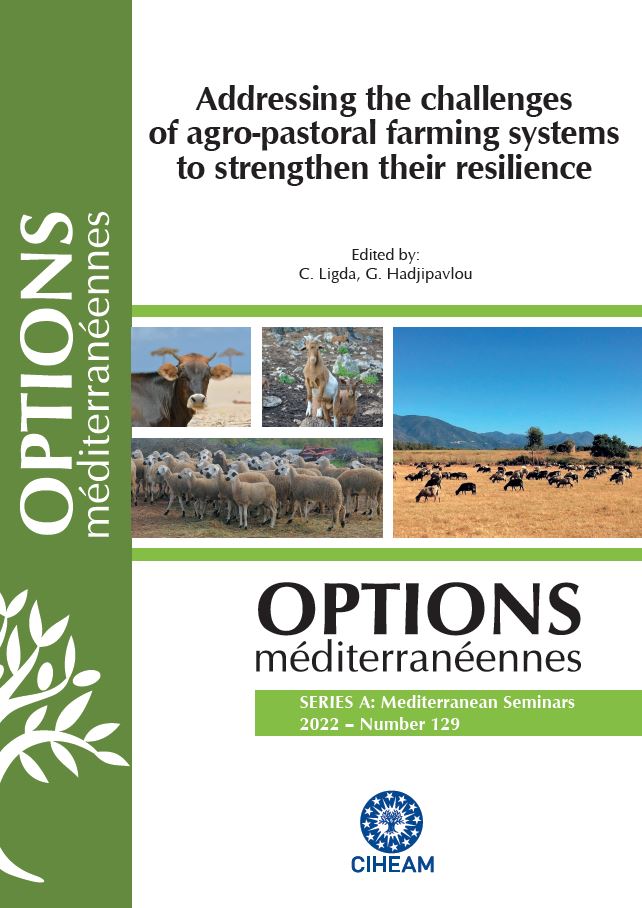| Article précédent | p. 63-72 | Article suivant |
Environment and biometry in the sheep breeds of North-West Portugal
The North-West region of Portugal has undergone a profound change in its agricultural structure, with the abandonment of agricultural activity but increasing the use of autochthonous sheep breeds. These sheep, which are exploited for meat production, can belong to Bordaleira Entre Douro e Minho (BEDM) breed, usually accompany cattle in the pasture, well-formed and moderately developed or Churra do Minho (CM), small sheep with coarse and long wool, that graze exclusively in herds, traditionally kept in turn by the farmers. The aim of this study is to evaluate the adaptability to different ecosystems and the environment influence, in particular altitude, to the breeds morphometric parameters. A total of 1394 BEDM females and 908 CM females were analysed and conformation, productivity and mobility measures were estimated. Our results present significant differences (P≤ 0.05) between breeds and age, with higher values in BEDM, relatively to structure parameters. Significant differences were found, regarding breed in functionality. These biometric differences contribute to explain the geographic distribution of breeds, BEDM occupying the valleys, rarely exceeding 600m in altitude and CM the highest mountains where poor soils predominate, with rocky outcrops and sporadic agricultural crops – scrub, low grass and shrub plants, with low energy levels and poor digestibility.
La région du nord-ouest du Portugal a subi un profond changement dans sa structure agricole, avec l’abandon de l’activité agricole mais en augmentant l’utilisation de races ovines autochtones. Ces ovins exploités pour la production de viande peuvent appartenir à la race Bordaleira Entre Douro e Minho (BEDM), accompagnent généralement les bovins au pâturage, bien formés et moyennement développés ou Churra do Minho (CM), petits ovins à laine grossière et longue, pâturés exclusivement en troupeaux, traditionnellement gardés à leur tour par les agriculteurs. L´objective de cette étude est d’évaluer l’adaptabilité à différents écosystèmes et l’influence de l’environnement, en particulier l’altitude, sur les paramètres morphométriques des races. Un total de 1394 femelles de la race BEDM et 908 femelles de race CM. ont été analysés et les mesures de conformation, de productivité et de mobilité ont été estimées. Nos résultats présentent des différences significatives (P ≤ 0,05) entre races et âge, avec des valeurs plus élevées chez BEDM, par rapport aux paramètres de structure. Des différences significatives ont été trouvées, concernant la race, dans la fonctionnalité. Ces différences biométriques contribuent à expliquer la répartition géographique des races, occupant BEDM les vallées, dépassant rarement 600m d’altitude et CM les plus hautes montagnes où prédominent les sols pauvres, avec des affleurements rocheux et des cultures agricoles sporadiques – broussailles, herbes basses et arbustes, à faible niveaux d’énergie et mauvaise digestibilité.
- [ Afficher ]
- [ Télécharger ]
- [ Exporter la citation ]
Vous pouvez télécharger la citation au format :
- [ Imprimer ]
-
Mots-clés
ALTITUDE, BIOMETRIE, ELEVAGE, ENVIRONNEMENT, OVIN, PHENOTYPE, RACE (ANIMAL)Citer cet article
Nuno V. Brito, Lopes J.C., Ribeiro V., Dantas R., Leite J.V. Environment and biometry in the sheep breeds of North-West Portugal. In : Hadjipavlou G. (ed.), Ligda C. (ed.). Addressing the challenges of agro-pastoral farming systems to strengthen their resilience. Zaragoza : CIHEAM, 2022. p. 63-72. (Options Méditerranéennes : Série A. Séminaires Méditerranéens; n. 129). 71. Annual Meeting of the European Federation of Animal Science, 2021/12/03, Online. http://om.ciheam.org/om/pdf/a129/00008098.pdf



